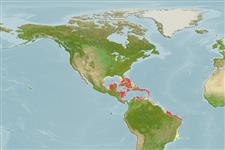>
Gobiiformes (Gobies) >
Gobiidae (Gobies) > Gobiinae
Etymology: Coryphopterus: Greek, koryphe = summit + Greek, pteron = fin, wing (Ref. 45335).
More on authors: Böhlke & Robins.
Environment: milieu / climate zone / Tiefenbereich / distribution range
Ökologie
seewasser riff-verbunden; tiefenbereich 6 - 30 m (Ref. 9710). Tropical
Western Atlantic: southern Florida, USA and Bahamas to the Lesser Antilles (Ref. 7251). Has occasionally been recorded in northeastern Brazil (Ref. 84211).
Size / Gewicht / Alter
Geschlechtsreife: Lm ? range ? - ? cm
Max length : 6.0 cm TL Männchen/unbestimmt; (Ref. 7251)
Rückenflossenstacheln (insgesamt) : 6 - 7; Rückenflossenweichstrahlen (insgesamt) : 9 - 11; Afterflossenstacheln: 1; Afterflossenweichstrahlen: 8 - 9. Translucent gray with a narrow yellow stripe, faintly edged with dusky pigment, extending posteriorly from eye, and small yellow or dusky yellow spots or short bands on snout, cheek and anteriorly on body; a row of small faint yellow spots dorsally on body (Ref. 13442).
Body shape (shape guide): fusiform / normal.
Inhabits reef areas deeper than 6 m.
Life cycle and mating behavior
Geschlechtsreife | Fortpflanzung | Ablaichen | Eier | Fecundity | Larven
Benthic spawner.
Robins, C.R. and G.C. Ray, 1986. A field guide to Atlantic coast fishes of North America. Houghton Mifflin Company, Boston, U.S.A. 354 p. (Ref. 7251)
IUCN Rote Liste Status (Ref. 130435: Version 2025-1)
Bedrohung für Menschen
Harmless
Nutzung durch Menschen
Fischereien: kommerziell; Aquarium: Kommerziell
Tools
Zusatzinformationen
Download XML
Internet Quellen
Estimates based on models
Preferred temperature (Ref.
123201): 26.4 - 28.2, mean 27.5 °C (based on 597 cells).
Phylogenetic diversity index (Ref.
82804): PD
50 = 0.5001 [Uniqueness, from 0.5 = low to 2.0 = high].
Bayesian length-weight: a=0.01023 (0.00477 - 0.02194), b=3.01 (2.83 - 3.19), in cm total length, based on LWR estimates for this (Sub)family-body shape (Ref.
93245).
Trophic level (Ref.
69278): 2.0 ±0.00 se; based on food items.
Widerstandsfähigkeit (Ref.
120179): hoch, Verdopplung der Population dauert weniger als 15 Monate. (Preliminary K or Fecundity.).
Fishing Vulnerability (Ref.
59153): Low vulnerability (10 of 100).
🛈
Nutrients (Ref.
124155): Calcium = 194 [98, 437] mg/100g; Iron = 1.15 [0.55, 2.23] mg/100g; Protein = 17.9 [15.8, 19.6] %; Omega3 = 0.137 [0.061, 0.273] g/100g; Selenium = 25.8 [12.5, 56.7] μg/100g; VitaminA = 107 [24, 421] μg/100g; Zinc = 3.16 [2.00, 4.85] mg/100g (wet weight);
